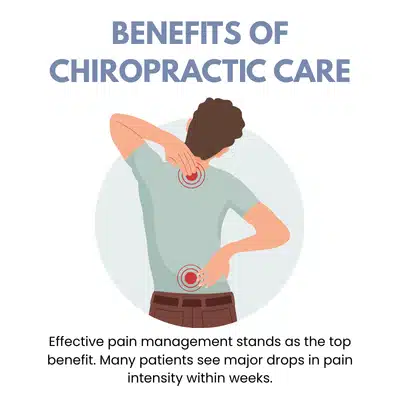Low back pain affects most people at some point. About 80% of adults deal with this problem during their lives. It causes missed work days and limits daily activities. The pain can be mild or severe, lasting weeks or months.
Chiropractic care offers a drug-free path to relief. This natural approach focuses on spine health and treats the root causes of pain. Many medical guidelines now recommend chiropractic treatments as first-line therapy for back problems.
What Causes Low Back Pain

Several spine conditions can trigger back pain. Common causes include muscle strains from lifting or sudden movements. Soft tissue injuries from accidents also create problems. Disc issues like herniation or degeneration cause many cases. Simple stretching improves flexibility.
These problems often lead to inflammation and nerve compression. A herniated disc can press on nerve roots and cause sciatica. This condition affects up to 40% of people and sends pain down the leg.
Pain intensity varies from person to person. You might feel constant aching or sharp pain that comes and goes. Certain pain triggers make it worse. Sitting too long, poor posture, or twisting motions can flare up symptoms. Targeted care aims for pain relief.
Finding the source matters for effective treatment. A proper diagnosis guides the best approach to healing and wellness.
Your First Chiropractic Visit
Your initial consultation covers your health history and symptoms, including spine conditions and sciatica. The chiropractor asks about when pain started and what makes it better or worse. They want to know your pain intensity on a scale.
A physical exam follows this discussion. The doctor checks your spinal alignment and joint function. They test reflexes and muscle strength and check for muscle tension. This assessment helps identify the problem areas.
Sometimes imaging is needed for a complete picture. X-rays show bone structure and alignment issues. An MRI reveals soft tissue details like disc problems or nerve compression that may cause sciatica. These tools ensure accurate diagnosis of your condition and clarify spine conditions.
The chiropractor then creates a personalized treatment plan for pain management. Your patient preferences guide this process. The plan outlines recommended adjustments frequency and goals for improving pain and mobility.
Core Chiropractic Treatments
Spinal Adjustments and Manipulation

Spinal manipulation forms the foundation of chiropractic care. During adjustments, controlled force realigns the spine and restores normal motion. This corrects joint restrictions and relieves nerve pressure.
Research shows spinal manipulation provides significant pain relief. A 2019 study found it works as well as other recommended treatments for chronic back pain. These adjustments improve joint function and nervous system function by removing interference.
Supporting Therapies and Exercises
Chiropractic care goes beyond just adjustments. Muscle therapy and massage therapy address soft tissue problems. These techniques relax tight muscles and improve blood flow. They work with adjustments to provide complete relief.
Exercise programs strengthen core muscles that support your spine. Stretching routines improve flexibility and mobility. Building this support system helps maintain proper alignment and prevents future problems.
Additional Treatment Methods
Some chiropractors use additional methods like traction or heat therapy. This holistic approach treats bones, joints, muscles, and nerves together. It creates lasting results without drugs or surgery.
Benefits of Chiropractic Care

Effective pain management stands as the top benefit. Many patients see major drops in pain intensity within weeks. A military study showed adding chiropractic treatments to medical care produced better results than medicine alone.
Improved mobility and flexibility come next. As joints move better and muscles balance out, patients regain range of motion. Better posture follows as the spine realigns and support muscles strengthen.
The wellness focus sets chiropractic care apart. Doctors discuss lifestyle factors that contribute to pain. They offer guidance on work setup, daily habits, and stress management. This prevents future episodes and supports long-term health.
Reduced need for pain medications provides major benefits. Research shows people who see chiropractors first have 90% lower odds of needing opioids. This drug-free approach avoids side effects and dependency risks.
Safety and Effectiveness
Chiropractic care has strong safety records when done by licensed professionals. Studies show it works as well as standard medical treatments for back pain. Patient satisfaction rates remain high across multiple research studies.
Side effects are typically mild and brief. Some people feel soreness or stiffness after treatment. This resembles how muscles feel after exercise and fades within days.
Serious risks from lower back manipulation are extremely rare. Chiropractors screen for conditions that would make treatment unsafe. They refer patients to other specialists when needed.
Individual responses vary like any therapy. Some people improve quickly while others with chronic conditions need more time. Regular progress checks help adjust your treatment plan as needed.
Long-Term Spine Health

Prevention plays a key role in chiropractic wellness. Beyond treating current pain, doctors teach habits that keep your spine healthy. This includes specific rehabilitation exercises for core and back muscles.
Posture and ergonomics training prevents future problems. Small changes in how you sit, stand, and lift make big differences. Taking breaks from prolonged positions reduces strain on your lower back.
Many chiropractors provide broader wellness advice. They may discuss nutrition, stress management, and self-care practices. Some work with massage therapy or physical therapy providers for complete care.
This comprehensive approach builds resilience against future pain episodes. It treats not just symptoms but underlying causes of back problems.
Take Action for Your Back Health
Living with chronic back pain limits your life quality. But you have options beyond just pain medications or surgery. Chiropractic care offers proven back pain treatment through natural methods.
The combination of adjustments, muscle tension relief, and lifestyle guidance addresses all aspects of spine health. Research backs its effectiveness for reducing pain and improving function. Many patients avoid long-term medication use through this approach.
Success requires partnership between you and your chiropractor. They bring expertise in spinal health while you commit to recommended treatments and healthy habits.
Don’t let back pain control your life any longer. Schedule a consultation with a qualified chiropractor today. Take the first step toward pain-free living and get back to doing what you love.
